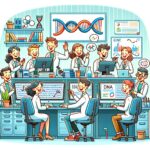
Foundations and Applications of Bioinformatics
December 19, 2024Introduction
Bioinformatics, a term first introduced by Paulien Hogeweg and Ben Hesper in 1979, refers to the study of informational processes in biological systems. It is an interdisciplinary science focused on collecting, classifying, storing, and analyzing complex biological data using computational tools and methods. This field bridges biology, computer science, and information technology, providing essential methods and software for understanding and interpreting biological information.
Bioinformatics encompasses diverse tasks, including algorithm development and data mining. Algorithms are defined as structured processes or sets of rules for problem-solving, particularly suited for computational applications. Data mining involves exploring extensive databases to uncover new insights. According to the National Center for Biotechnology Information (NCBI, 2001), bioinformatics is the convergence of biology, computer science, and information technology into a unified discipline. Its primary subfields include:
- Developing new algorithms and statistical tools for analyzing large datasets.
- Interpreting diverse biological data types, such as nucleotide sequences, protein domains, and structural information.
- Creating tools to facilitate efficient access, integration, and management of biological data.
Branches of Bioinformatics
- Computational Biology: Develops and applies analytical, mathematical, and computational methods to study biological, ecological, and social systems.
- Genomics: Examines the structure, function, and mapping of genomes.
- Proteomics: Focuses on studying the proteome, including protein expression patterns and their links to diseases or environmental changes.
- Structural Biology: Investigates the molecular structure and dynamics of macromolecules like proteins and nucleic acids.
- Systems Biology: Analyzes interactions among biological components, integrating them through computational modeling.
- Pharmacogenomics: Studies the genetic basis of drug responses in individuals.
Aims of Bioinformatics
Bioinformatics aims to:
- Apply computational tools to solve biological problems.
- Present complex biological data in user-friendly formats.
- Develop statistical and graphical tools for genomic data analysis.
- Facilitate the integration of biological metadata with experimental data.
- Establish collaborations among academia, industry, and government entities to advance bioinformatics research.
Scope of Bioinformatics
Bioinformatics merges biology and computer science to address critical questions in genomics, proteomics, and systems biology. Current research includes studying gene and protein sequences to understand evolution, modeling protein structures computationally, and analyzing mass spectrometry data to investigate links between phosphorylation and cancer. Career opportunities span academia, research institutions, biotechnology, and the pharmaceutical industry.
Research Areas in Bioinformatics
- Computational Evolutionary Analysis: Tracks organismal evolution through DNA changes.
- Sequence Analysis: Enables large-scale nucleotide and protein sequencing.
- Genome Annotation: Identifies genes and biological features in DNA sequences.
- Gene Expression Analysis: Quantifies mRNA levels using RNA-Seq or microarray techniques.
- Cancer Mutation Analysis: Identifies genetic mutations for precise diagnosis and treatment.
- Comparative Genomics: Traces evolutionary divergence among species by comparing genes.
Bioinformatics Databases
Bioinformatics databases organize biological data for retrieval and analysis:
- Primary Databases: Store raw data, e.g., GenBank and Protein Data Bank (PDB).
- Secondary Databases: Provide curated information, e.g., SWISS-Prot and PIR.
- Specialized Databases: Focus on niche topics, e.g., FlyBase and the HIV sequence database.
Structural Bioinformatics in Drug Discovery
Structural bioinformatics predicts protein 3D structures to design novel therapies. Techniques such as homology modeling, molecular docking, and simulations are critical for studying protein-ligand interactions. Tools like MODELLER, UCSF Chimera, and PyMOL aid in structure prediction and refinement, while databases like SwissDock and SwissTargetPrediction support drug-target interaction studies.
Conclusion
Bioinformatics integrates biology, computer science, and information technology to analyze and interpret biological data. With applications spanning genomics, proteomics, and drug discovery, the field continues to evolve and address pressing challenges in personalized medicine and global health.
















